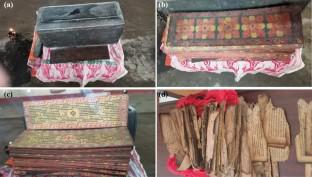Restoration and conservation of Sāncipāt manuscripts of Assam for preserving in ordinary rural setup
IF 0.1
Q4 HISTORY & PHILOSOPHY OF SCIENCE
引用次数: 0
Abstract
Tens of thousands of Sāncipāt manuscripts, written on beautiful folios called Sāncipāt made of Sānci-bark, were popular in Assam from the early medieval period till the early twentieth century and are testimonies of a rich cultural and literary heritage. Baring a small fraction conserved under a passive environment in libraries and museums, most of these manuscripts are traditionally stored under ordinary rural conditions for occasional reading. Properly prepared Sāncipāt can survive centuries due to robust physical strength and resistance against fungus, insects, and humidity. Sāncipāt was traditionally coated with antifungal, insect-repellant, and decorative Hāitāl and Hengul pigments and subsequently coated with humidity-resistant natural varnishing called Lā-coating. However, natural weathering for centuries has caused damage to Sāncipāt manuscripts, particularly those without Hengul-Hāitāl and Lā-coatings. These manuscripts urgently need to be preserved as and where they are adequate since conservation of the huge number of manuscripts in a passive environment is impractical in the rural setup. This paper shows that some chemicals used in the conservation of paper have harmful effects on Sāncipāt, which markedly differ from paper in physical and chemical characteristics. We also propose a method for restoring and conserving Sāncipāt manuscripts based on the traditional method of their preparation without using any such chemicals. This involves mild physical cleaning, mending with fresh Sāncipāt and natural gum, applying antifungal and insect-repellant pigments in the free spaces, and finally applying Lā-coating (varnishing) in the traditional way. Results of a piloting of the method with fourteen manuscripts have been presented.

恢复和保护Sāncipāt阿萨姆邦手稿,以便在普通农村地区保存
数以万计的Sāncipāt手稿,写在美丽的对开本Sāncipāt上,由Sānci-bark制成,从中世纪早期到20世纪初在阿萨姆邦流行,是丰富的文化和文学遗产的见证。除了一小部分在图书馆和博物馆的被动环境下保存,大多数手稿传统上都保存在普通的农村条件下,供偶尔阅读。适当的准备Sāncipāt可以保存几个世纪,因为强大的物理强度和抵抗真菌,昆虫和湿度。Sāncipāt传统上涂有抗真菌、驱虫和装饰性的Hāitāl和Hengul颜料,随后涂上抗湿的天然清漆Lā-coating。然而,几个世纪以来的自然风化已经对Sāncipāt手稿造成了破坏,特别是那些没有Hengul-Hāitāl和Lā-coatings的手稿。这些手稿迫切需要保存,因为在一个被动的环境中保存大量的手稿在农村是不切实际的。本文表明,一些用于纸张保存的化学物质对Sāncipāt有有害影响,其物理和化学特性与纸张明显不同。我们还提出了一种基于传统制备方法而不使用任何此类化学品的方法来恢复和保存Sāncipāt手稿的方法。这包括温和的物理清洁,用新鲜的Sāncipāt和天然口香糖修补,在空闲的地方涂上抗真菌和驱虫的颜料,最后用传统的方法涂Lā-coating(清漆)。对该方法的14篇论文进行了试验,并给出了试验结果。
本文章由计算机程序翻译,如有差异,请以英文原文为准。
求助全文
约1分钟内获得全文
求助全文

 求助内容:
求助内容: 应助结果提醒方式:
应助结果提醒方式:


